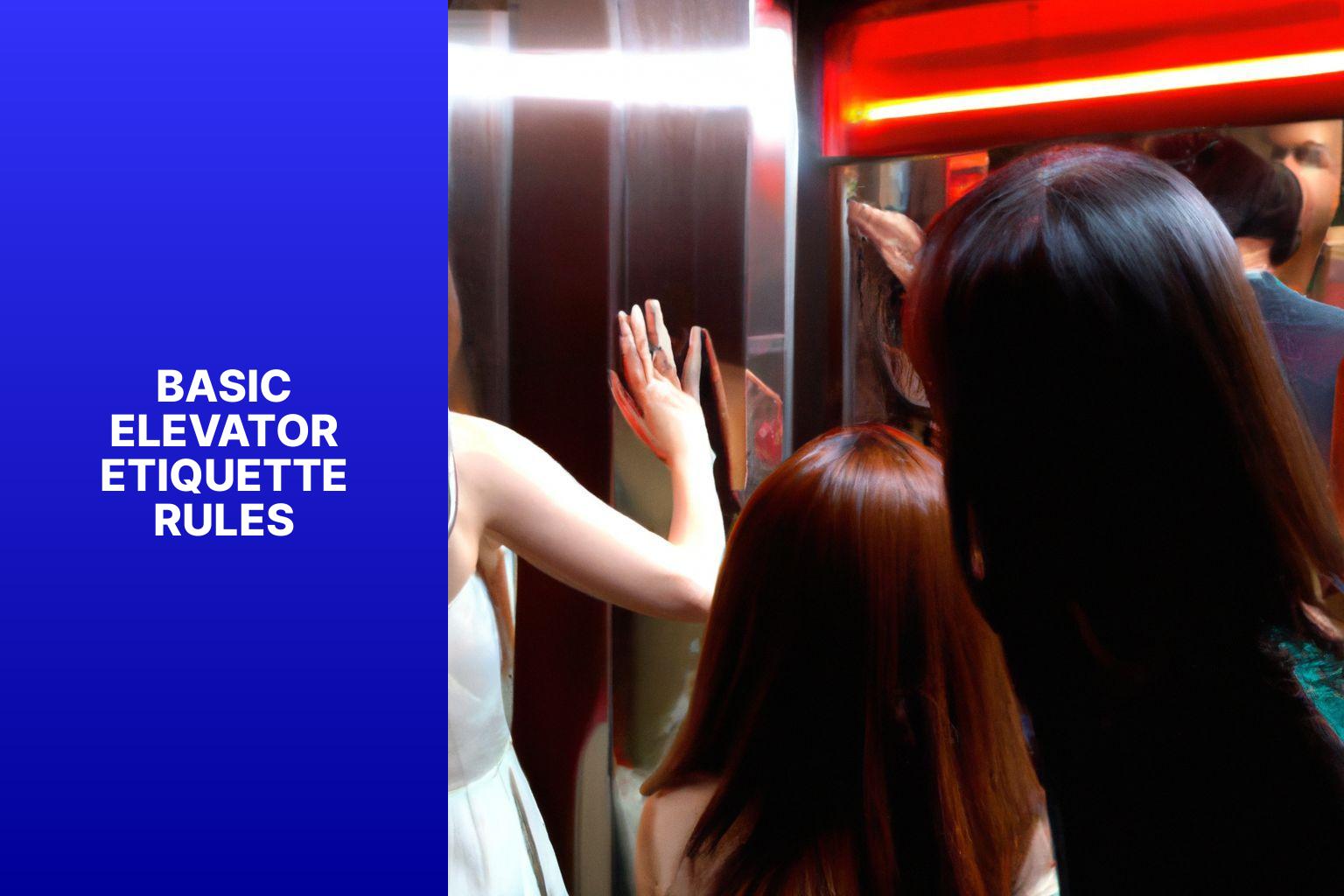Elevator Etiquette: The Ups and Downs of Shared Spaces
Elevator etiquette is an important aspect of navigating shared spaces. It involves showing respect for personal space, promoting efficiency, and ensuring a smooth and comfortable experience for everyone. Understanding and practicing proper elevator etiquette is crucial for maintaining a harmonious and considerate environment.
Respecting personal space is a key element of elevator etiquette. By allowing individuals to maintain their personal space, we create a comfortable environment for everyone. promoting efficiency is equally important. This means being mindful of others by standing to one side to allow people to enter and exit efficiently, giving priority to those with disabilities or in need, and keeping conversations and noise to a minimum.

There are basic elevator etiquette rules to follow. These include being mindful of personal hygiene, not holding the door open for extended periods, avoiding crowding the elevator, and allowing others to press their floor buttons. By adhering to these guidelines, we can ensure a smoother and more enjoyable elevator experience for all.
Dealing with awkward elevator situations can also be challenging. This includes entering and exiting with a large group, riding with strangers, and handling emergencies. Understanding how to navigate these situations with grace and respect is important for maintaining a positive atmosphere.
It is also essential to recognize and respect cultural differences in elevator etiquette. Different approaches to personal space, varying norms of politeness, and language and communication differences can all impact elevator interactions. Being aware of these cultural nuances can help avoid misunderstandings and promote inclusivity in shared spaces.
Key Takeaways:
- Elevator etiquette promotes a harmonious shared space: Following elevator etiquette rules ensures a respectful and efficient experience for everyone. It helps maintain personal space and reduces awkward situations.
- Respecting personal space is vital: By standing to one side, giving priority to those in need, and avoiding crowding, elevator riders can respect personal space and make the ride more comfortable.
- Cultural differences impact elevator etiquette: Understanding varying norms of politeness, personal space, and communication is important when sharing an elevator with individuals from different cultures.
Why Is Elevator Etiquette Important?
Navigating the confined world of elevators can sometimes feel like a social experiment gone wrong. But why is elevator etiquette so crucial? In this section, we’ll uncover the reasons behind the importance of elevator etiquette. From respecting personal space to promoting efficiency, we’ll explore how these elements contribute to a harmonious and pleasant elevator experience. So, let’s dive in and discover the ups and downs of elevator etiquette!
Respecting Personal Space
Respecting Personal Space promotes a comfortable elevator experience. Here are key points to consider:
1. Stand to one side to allow easy entry and exit, preventing unnecessary crowding.
2. Prioritize and assist those with disabilities, ensuring enough space for maneuvering.
3. Keep conversations and noise to a minimum to avoid invading personal space. For more information on elevator etiquette, you can visit Elevator Etiquette: The Ups and Downs of Shared Spaces.
4. Maintain personal hygiene, including fresh breath and avoiding strong perfumes.
5. Avoid holding the door open for too long to prevent delays and congestion.
6. Do not overcrowd the elevator; wait for the next one if necessary.
7. Allow others to press their floor buttons, respecting their autonomy.
By following these guidelines, we can create a harmonious elevator environment and ensure a pleasant experience for all passengers.
Promoting Efficiency
Promoting efficiency in elevator etiquette is crucial for smooth and fast movement of people and minimizing delays. Here are some key practices to ensure efficiency:
- Add Enter and exit promptly: Stand to one side of the elevator doors to allow others to enter or exit smoothly. Avoid blocking the entrance or exit, which can cause unnecessary delays.
- Add Use your time wisely: Keep conversations and noise to a minimum to respect others’ time. Excessive talking or loud noises can disrupt the peaceful environment and make the ride uncomfortable.
- Add Press the right floor buttons: Let others press their floor buttons without interruption. Only press the buttons necessary for your own floor to avoid unnecessary stops and delays for others.
- Add Avoid holding the door open: Holding the elevator door open for a long time can disrupt the flow of movement and cause delays. If someone is rushing to catch the elevator, politely inform them that you cannot hold the door open for an extended period.
- Add Avoid overcrowding: Be mindful of the elevator’s maximum capacity and avoid overloading it. Overcrowding can lead to discomfort and safety hazards. If the elevator is full, wait for the next one instead of trying to squeeze in excessively.
By following these practices, we can promote efficiency in elevator usage and ensure a smooth and comfortable experience for everyone. Efficient elevator etiquette creates a harmonious environment and helps in utilizing this shared space effectively.
Basic Elevator Etiquette Rules

Photo Credits: Www.Moderngentlemanmagazine.Com by Roger Taylor
Let’s dive into the basic elevator etiquette rules that can make your ride smoother and more pleasant. From standing to one side to allow others to enter or exit, to giving priority to those with disabilities or in need, these simple practices ensure a considerate and inclusive elevator experience. We’ll also touch on the importance of keeping conversations low and being mindful of personal hygiene. And remember, avoiding crowding, not holding the door open for too long, and allowing others to press their floor buttons are all part of being a respectful elevator passenger.
1. Stand to One Side to Allow Others to Enter/Exit
Stand to one side to allow others to enter or exit smoothly. Here are some steps to follow for a harmonious and efficient elevator experience:
– Position yourself to one side of the doors while waiting for the elevator, leaving space for others to enter or exit.
– Step aside if someone inside the elevator needs to exit on your floor.
– If someone is waiting to enter while you are inside the elevator, step towards the back or side to create space for them.
– Avoid crowding the entrance, as it can make it difficult for others to get in or out.
– If the elevator is full and you are near the buttons, offer to press a button for someone else’s floor to speed up the process.
– Be mindful of the flow of traffic and avoid blocking the doors.
– Stay aware of your surroundings and be prepared to adjust your position for others.
Following these steps will promote efficiency, prevent congestion, and ensure smooth entry and exit for everyone in the elevator.
2. Give Priority to Those with Disabilities or in Need
When it comes to elevator etiquette, it is crucial to give priority to individuals with disabilities or who are in need in order to create a considerate and inclusive environment. Here are some guidelines to follow:
1. Offer assistance: If you see someone with a disability or who appears to need help, offer your assistance without assuming they want or need it. Respect their autonomy and let them decide if they require help.
2. Allow them to enter and exit first: When the elevator arrives, stand to one side and allow those with disabilities or mobility issues to enter and exit before you. This ensures they have enough space and time to move safely.
3. Be patient: If someone with disabilities or needing extra time is taking longer to board or exit the elevator, be patient and understanding. Rushing or showing impatience can cause stress or discomfort.
4. Give up your spot: If the elevator is crowded and someone with disabilities or needing a seat enters, offer your spot to them. This shows empathy and kindness towards their situation.
5. Follow their lead: If someone with a disability is using a wheelchair or cane, let them guide the elevator ride. Don’t try to take control or assume you know what’s best for them.
6. Use accessible buttons: If you notice someone struggling to reach or press the elevator buttons, offer to help or use the accessible buttons if available.
7. Create a welcoming environment: Ensure the elevator is accessible and free from obstacles for easy navigation for those with disabilities. Respect personal space and avoid crowding to make everyone comfortable.
By giving priority to individuals with disabilities or those in need, we can foster a more inclusive and compassionate elevator experience for everyone.
3. Keep Conversations and Noise to a Minimum

When riding an elevator, it is important to keep conversations and noise to a minimum to ensure a comfortable and respectful environment. By following these steps, you can help maintain a peaceful atmosphere:
- Speak softly: Engage in conversations using a low volume to maintain a peaceful atmosphere.
- Avoid phone calls: Keep phone conversations brief and use a quiet speaking volume. Consider stepping out of the elevator for longer or noisier conversations.
- Avoid loud music or headphones: If listening to music or using headphones, keep the volume low to avoid disturbing others.
- Limit unnecessary noise: Avoid tapping, whistling, or making loud sounds.
- Be aware of your surroundings: Adjust your behavior according to the noise level. Follow the lead of others engaged in quiet activities.
By keeping conversations and noise to a minimum, you contribute to a more pleasant elevator experience for everyone.
4. Be Mindful of Personal Hygiene
When riding an elevator, it is important to be mindful of personal hygiene in order to ensure a pleasant experience. Here are some steps you can follow:
- Remember to cover your mouth and nose when coughing or sneezing, using a tissue or your elbow.
- Avoid wearing strong perfumes or colognes that may overwhelm others.
- Maintain good body odor by using deodorant or antiperspirant.
- Dispose of trash and food wrappers properly, making sure not to leave them in the elevator.
- Avoid bringing strong-smelling foods into the elevator, as it may be unpleasant for others.
- If you are feeling unwell or have a contagious illness, consider taking the stairs instead of the elevator.
- Remember to regularly wash your hands and use hand sanitizer after touching elevator surfaces.
- Avoid touching your face, especially your eyes, nose, and mouth, while in the elevator.
- If you have a mask, make sure to wear it properly in order to prevent the spread of germs.
By being mindful of personal hygiene in elevators, we can create a more pleasant and comfortable environment for everyone.
5. Do Not Hold the Door Open for Extended Periods
When it comes to elevator etiquette, it is important to follow certain rules for a smooth and efficient experience. One crucial rule is to not hold the door open for extended periods. Here are the steps to follow:
1. Exit the elevator promptly when you reach your desired floor. Holding the door open for too long can inconvenience others and cause delays.
2. If you see someone approaching the elevator while the doors are closing, press the “Open” button to hold the elevator temporarily. Do not hold it open for an extended period if the person is not near.
3. Understand that holding the door open for too long disrupts the flow of the elevator and can cause delays and frustration for other passengers.
4. Be mindful of the time spent holding the door open. If someone is too far away or not in immediate need of the elevator, it is best to close the door and continue the journey.
5. Remember that the elevator is a shared space and everyone’s time is valuable. Holding the door open for extended periods can inconvenience other passengers and disrupt the efficiency of the elevator system.
By following these steps and being considerate towards others, you can contribute to a harmonious elevator experience.
6. Avoid Crowding the Elevator
- Step aside: When entering the elevator, stand to one side and leave space for others to enter or exit.
- Mind personal space: Be aware of personal space and avoid crowding others inside the elevator. Maintain a comfortable distance to ensure everyone has enough room.
- Wait for the next one: If the elevator is crowded or reaching its maximum capacity, consider waiting for the next one. Prioritize safety and comfort for everyone.
- Let others press their floor buttons: If someone is near the elevator buttons, give them space and opportunity to press their desired floor. Avoid reaching over or pushing past others.
- Consider multiple elevators: In crowded areas or during peak times, there may be multiple elevators available. Utilize different elevators to prevent overcrowding.
- Be patient: In a crowded elevator, be patient and understanding. It might take a little longer to reach your destination due to the crowded conditions.
- Exit promptly: When you reach your floor, exit the elevator promptly. Avoid blocking the entrance or delaying others from getting off the elevator.
7. Allow Others to Press Their Floor Buttons
When it comes to elevator etiquette, let others press their floor buttons for a smooth and efficient experience.
- Respect personal space: Allow those who reach the buttons before you to press their floor without interruption or rushing.
- Promote efficiency: Allowing others to press their floor buttons avoids delays and ensures smooth elevator operation.
- Be mindful of others: Grant everyone the opportunity to select their floor for fairness and respect.
- Show consideration: Help those who have difficulty reaching the buttons by pressing their desired floor for them.
- Avoid unnecessary contact: Letting others press their floor buttons reduces physical contact and maintains social distancing, which is particularly important today.
- Follow social norms: Respect cultural practices that allow the person closest to the buttons to press them.
- Ensure a pleasant ride: By letting others press their floor buttons, you create a comfortable elevator environment for everyone.
By allowing others to press their floor buttons, you contribute to a positive elevator experience for all.
Dealing with Awkward Elevator Situations

Photo Credits @realjoeyfatone
Navigating through elevator encounters can be quite a challenge. From entering and exiting with a large group, to sharing the elevator with strangers, and even dealing with unexpected emergencies – we’ve all been there. In this section, we’ll uncover the ins and outs of handling these awkward elevator situations. Get ready to uncover some practical tips and tricks to make your elevator rides a little less daunting. Strap in, we’re in for a bumpy (yet enlightening) ride!
1. Entering and Exiting with a Large Group
Entering and exiting an elevator with a large group requires coordination and proper etiquette for a smooth experience. Coordinate beforehand: Plan ahead if you’ll be with a large group. This helps everyone be prepared and move quickly.
Stand close to the doors: When the elevator arrives, have people at the front stand close to the doors. This makes it easier to enter or exit without delays.
Let others exit first: When the elevator arrives at the desired floor, allow anyone inside who wants to exit before entering. This keeps the flow smooth and prevents congestion.
Move efficiently: Once inside, move to the back or sides to create space for others. Avoid blocking the doors, which hinders other passengers.
Be courteous and patient: Entering or exiting may take longer with a large group. Stay patient and considerate towards others waiting.
By following these guidelines, entering and exiting with a large group can be a pleasant experience. Remember to be aware of your surroundings, prioritize others’ needs, and maintain respectful and efficient behavior throughout the process.
2. Riding with Strangers
Riding with strangers in an elevator can feel uncomfortable, but there are etiquette rules to follow for a smooth experience. When riding with strangers, it is important to maintain personal space and stand to one side for easy entry and exit. This prevents overcrowding and promotes efficiency. It is also crucial to respect priority and give priority to those with disabilities or in need. If required, offer assistance such as holding the door for someone with mobility issues. Keeping noise low is essential for a comfortable ride. Have quiet conversations and maintain low noise levels. Another important consideration is personal hygiene. Be mindful of your hygiene and avoid using strong perfumes or having body odors that may discomfort others. It is vital to avoid holding the elevator door open for too long as this can delay others and disrupt the flow. Be conscious of the space and avoid crowding others, leaving enough room for everyone to stand comfortably. If someone gets to the button panel before you, allow them to press their floor button. This shows respect and ensures everyone can control their own floor selection. By following these etiquette rules, riding with strangers in an elevator can be a more pleasant and respectful experience for everyone.
3. Dealing with Emergencies
During emergencies in elevators, it is important to remain calm and take the necessary steps to ensure passenger safety. Here are some guidelines to follow when dealing with emergencies:
1. Assess the situation: Take the time to evaluate the nature of the emergency, whether it is a power outage or a mechanical failure.
2. Alert others: Utilize the emergency button or intercom to inform building security or maintenance about the situation. If there is no response, contact emergency services.
2. Alert others: Utilize the emergency button or intercom to inform building security or maintenance about the situation. If there is no response, contact Elevator Etiquette: The Ups and Downs of Shared Spaces.
3. Stay inside the elevator: Unless there is an immediate danger, it is generally safer to remain inside until help arrives.
4. Communicate with passengers: In a calm manner, inform everyone about the situation and advise them to remain calm and still.
5. Stay near the doors: Position yourself close to the doors so that you have easier access in case help arrives or the doors can be opened manually.
6. Avoid forcing the doors open: Attempting to pry open the doors can be unsafe and may lead to more problems. It is best to wait for professional assistance.
7. Be cautious with the emergency stop button: Excessive pressing of the button can cause the elevator to get stuck between floors.
8. Follow instructions from authorities: It is important to listen to the guidance provided by building security, maintenance personnel, or emergency responders once they arrive.
9. Prepare emergency supplies: Keep a small kit with essential items like a flashlight, water, and a first aid kit in case of prolonged emergencies.
10. Seek medical attention if needed: If anyone requires immediate medical assistance, inform the emergency responders.
By following these steps, you can effectively handle emergencies and ensure the safety and well-being of everyone in the elevator.
Understanding Cultural Differences in Elevator Etiquette

Photo Credits: Www.Moderngentlemanmagazine.Com by Noah Lopez
Elevator rides can be an interesting glimpse into the intricacies of cultural differences. From personal space to norms of politeness, each elevator encounter is a unique microcosm of human behavior. In this section, we will explore the fascinating world of elevator etiquette, focusing on the different approaches to personal space, varying norms of politeness, and the influence of language and communication. Get ready to uncover the ups and downs of elevator interactions across diverse cultures.
1. Different Approaches to Personal Space
Different individuals have varying approaches to personal space. Having different thresholds for personal space in elevators is called proximity preferences. Some people prefer standing closer to others while others prefer more space. Being aware of and respecting each person’s preference is crucial.
Non-verbal cues, such as angling the body away or avoiding eye contact, can indicate someone’s need for personal space. Observing these signals can create a more comfortable environment for everyone. Personal space norms also differ across cultures. What may be appropriate in one culture might not be the same in another. Being sensitive to these cultural differences and adjusting accordingly is important.
Adapting to the situation is key, especially when the elevator is crowded. In such cases, it may be necessary to adjust personal space expectations to accommodate others. Flexibility and understanding contribute to a more pleasant elevator experience for everyone. By considering these approaches to personal space, individuals can promote a more respectful and comfortable atmosphere in elevators.
2. Varying Norms of Politeness
Varying norms of politeness exist in elevator etiquette across cultures and social contexts. It is important to respect personal space in many cultures, where individuals prefer to maintain distance and avoid physical contact, especially with strangers.
Politeness norms for greetings and acknowledgments differ among cultures. While some cultures expect a simple nod or smile, others exchange greetings like “hello” or “good morning“.
Holding the door open for others may be considered polite in certain cultures, but unnecessary or disruptive in others. Nonverbal cues, such as eye contact, also play a role in indicating politeness in different cultures.
The use of personal electronic devices, such as phones or headphones, may be accepted or frowned upon based on cultural norms.
In some cultures, it is common to wait for others to exit before entering, while in others, individuals enter and exit simultaneously without forming queues.
Giving priority to older individuals or those of higher social status is customary in cultures that value hierarchy and respect for elders.
By practicing elevator etiquette while being aware of and respecting these cultural differences, we can promote harmony and avoid unintentional discomfort or offense.
3. Language and Communication
Language and communication are the key principles of elevator etiquette. Clear and effective communication is crucial for avoiding misunderstandings and fostering a harmonious environment. Here are some important aspects to consider:
1. Use polite and respectful language: When interacting with others in the elevator, it is essential to utilize courteous and considerate language. Simple phrases like “please” and “thank you” go a long way in creating a friendly atmosphere.
2. Keep conversation volume appropriate: Given that elevators are small spaces, it is important to maintain conversations at a minimum volume. Avoid speaking loudly or engaging in disruptive conversations that may make others uncomfortable.
3. Respect personal space: To honor others’ personal space, it is important to maintain an appropriate physical distance. Refrain from crowding or standing too close to others. This helps create a comfortable environment for everyone.
4. Communicate elevator intentions: If you need to disembark at a specific floor, it is advisable to politely inform others by saying, “Excuse me, I need to get off at the next floor.” This conveys your intentions and allows others to make way for your exit.
5. Be aware of non-verbal communication: Non-verbal cues, such as body language and facial expressions, can also convey important messages. Be mindful of your non-verbal signals to ensure clear communication and respect towards others.
By practicing effective language and communication skills in elevators, we can create a more pleasant and respectful environment for everyone to enjoy.
Frequently Asked Questions
What is respiratory etiquette?
Respiratory etiquette refers to the practice of covering your mouth and nose with a tissue or your elbow when coughing or sneezing. This helps prevent the spread of germs and illnesses, especially in confined spaces like elevators.
What does good behavior in elevators entail?
Good behavior in elevators includes following common etiquette practices such as respecting personal space, avoiding unnecessary conversations, and allowing others to exit the elevator before entering. It also involves practicing proper hygiene, such as wearing a face mask, using hand sanitizer, and washing hands after exiting the elevator.
Is there any lift etiquette set by the city council?
Lift etiquette is not typically regulated by city councils. Basic rules of politeness and courtesy should always be followed in elevators to ensure a pleasant and safe experience for everyone.
What is the trampoline effect mentioned in elevator etiquette?
The trampoline effect refers to the bouncing or shaking of an elevator when a large group of people enters or exits at the same time. To avoid this, it is recommended to limit the number of people in the elevator and follow personal space guidelines.
Is it true that “ladies first” is an elevator etiquette rule?
While the practice of letting ladies go first in elevators may have existed in the past, it is not universally followed anymore. Elevator etiquette now emphasizes allowing others to exit before entering, regardless of gender.
Who is Anna Musson and what is her expertise in elevator etiquette?
Anna Musson is an etiquette expert and the founder of The Good Manners company. She provides advice and guidance on polite behavior in various settings, including elevators. Her expertise lies in promoting courteous and respectful behavior among individuals in social and professional environments.
